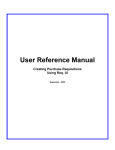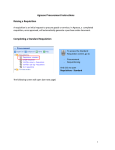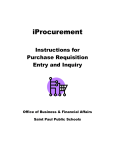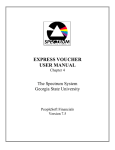Download TCAA-AC-AWS013 Technical Stores Management
Transcript
Advisory Circular TCAA-AC-AWS013 October 2007 TECHNICAL STORES MANAGEMENT 1.0 PURPOSE This Advisory Circular (AC) is issued to provide guidance on the establishment and management of maintenance facility technical stores. 2.0 REFERENCES Regulation 20(5) & (6) of the Civil Aviation (Approved Maintenance Organization) Regulations, 2006 sets requirements for an operator performing maintenance to establish technical stores. 3.0 GUIDANCE AND PROCEDURES 3.1 Parts and Materials Information: 3.1.1 Approved parts: An approved part is one that meets approved design data applicable to the part and having been manufactured and subsequently maintained in accordance with the requirements of the State of Design, Manufacture or Registry, as applicable. 3.1.2 Standard parts: Are approved parts conforming to national or industry accepted standard. 3.1.3 Unapproved Parts: These are parts that do not meet the criteria described in paragraphs 3.1.1 and 3.1.2; they also include parts improperly returned to service. 3.1.4 Parts and material acceptance: The process of evaluating parts and material for acceptance involves establishing that the part/material is authentic, conforms to the relevant type design, customers order, physical state and accompanying release documents. 3.2 Approved technical stores: a) Approved technical stores comprise of Quarantine and Bonded stores. (i) Quarantine Store - Incoming: Provide storage for incoming material and parts until such time as it can be ascertained that they are authentic and conform to the customer’s orders. (ii) Quarantine store – Unserviceable: Provide storage for parts and material awaiting investigation and dispatch for repair. TCAA-AC-AWS013 October 2007 Page 1 of 4 (iii) Bonded store: Provide storage of parts and material that have been proved authentic. 3.3 Approved Technical Stores Procedures – 3.3.1 The approved technical stores procedures will be contained in the user manual which could be a stand alone document or part of the MPM / MCM and will address the following: a) b) c) d) e) f) g) h) i) Quarantine and Bonded stores; Incoming and outgoing inspections; Shelf/storage life; Records control; Parts identification ( markings); Storage of instruments, tools, rubber items etc; Segregation of parts and materials in the bonded store; Storage facility; and Special storage. 3.4 Parts and Material Authenticity Evaluation: 3.4.1 Involves establishing that the parts and material conforms to approved design specifications, and have retained the essential properties assumed in the design as qualified by the supporting documents. 3.4.2 Information on the supporting documents shall include the following: a) The authority under which they are issued; b) Reference identification for the purposes of traceability; c) Name, address and approval reference of the issuing organization; d) Work order, contract or invoice number; e) Quantity, description, part numbers and, if applicable, serial numbers of the parts; f) Relevant information concerning any shelf life limitations, special storage condition requirements, compliance or non-compliance with any airworthiness directives, etc; g) The signature and approval reference of the person issuing the document; and h) Whether the part is new or used. 3.5 Parts and Material Suppliers These are organisations that hold parts and material for a limited period, the part and data being passed in their entirety to the operator, who has the obligation to ensure that the part is correct and that the documentation truly reflects the status of the part. 3.6 Salvaged Parts and Materials Parts removed from accident aircraft and aircraft no longer in service shall be tagged unserviceable, and shall be subjected to the normal unserviceable parts process. 3.7 Storage Procedure TCAA-AC-AWS013 October 2007 Page 2 of 4 3.7.1 The conditions of storage of aircraft supplies are important. The premises should be clean, well ventilated, and maintained at even dry temperature to minimise the effect of condensation. In many cases the manufacturer will specify the temperature and relative humidity in which the products should be stored. In case of such specific requirements, instruments and or Tell-Tell Desiccant must be in place to ensure such conditions are maintained within the specified range. 3.7.2 There must be a well defined procedure for receiving, storage, requisition and dispatch of aeronautical supplies. It is required that the receiving, quarantine, bonded, and dispatch functions of a technical store are segregated. 3.7.3 On reception after the aircraft supplies have been verified to: a) b) c) Comply with the order part number requirements. have the necessary certification and release to service documents be in generally good condition and has not sustained any damage 3.7.4 The supplies should be issued with a Goods Received Number (GRN) or (Batch Number) and a company Serviceable Label. The GRN shall be recorded on all the supplies incoming documents which must be preserved, and on the issued serviceable label which should be secured on the part or material before they are forwarded to the bonded stores. Note: The GRN enables the part or material to be traced to the in coming documents and its production source. It must be recorded on the aircraft records when the part is installed on the aircraft. 3.7.5 The serviceable label in addition to the GRN must indicate the part or material part number, serial number, special storage requirements, and shelf life as applicable. 3.7.6 Temperature and Humidity Control a) There should be a procedure to ensure that temperature and humidity are checked at regular intervals and recorded. b) Vapour Phased Inhibitor should only be used when approved by the manufacturer of the part. c) Where oils, fluids, or compounds are used as temporally protection on metal articles, it should be ascertained that the material and the method of application is approved by the manufacturer of the part. d) Desiccants e.g. silica-gel where used to protect stored parts, should be inspected and/or renewed at specified intervals or whenever airtight containers have been opened. 3.7.7 Racks and Bins – Clearly marked with the part number and bin location are preferred when the nature of the stoke permit their use because they allow free circulation of air. 3.7.8 Methods of storage should be such that batches of material or parts are issued in strict rotation, i.e. old stock should be issued before new stock. This caters for perishable goods, instruments and other components which have definite storage limiting periods. 3.7.9 Components and parts that have definite storage limiting period should have the storage limit date clearly indicated on the component tag. On expiry of the storage period the parts should be withdrawn from the stores for checking or overhaul as recommended by the manufacturer. The TCAA-AC-AWS013 October 2007 Page 3 of 4 effective storage limiting periods of some equipment may be considerably reduced if the recommended storage conditions are not provided. It is therefore important to note that the manufacturers recommended storage limiting periods can only apply in prescribed storage conditions. 3.7.10 Technical stores must have an acceptable easy procedure for management of components and material shelf storage limiting periods. 3.7.11 Segregation of Stock a) Materials which may have deleterious effects on others should be segregated, this is to prevent escaping fumes affecting the parts and or material. b) Flammable material such as dope, thinners, paint should be kept in a store isolated from the main building. 3.8 Requisition and Issuing of Parts 3.8.1 There should be an acceptable procedure for requisitioning parts and material from the technical stores. It is required that there are requisition forms and that parts should not be issued unless such filled forms have been presented. 3.8.2 The requisition shall be authorised by an appropriate personnel and shall be of a type that allows a copy to be retained by the stores for records and a copy to be sent with the issued part. It shall indicate the requisitioned part’s name, part number and aircraft or sub-component to which it shall be installed. 3.8.3 The stores personnel shall record on the requisition the serial number and the GRN (batch number) of the item issued. It is required that a copy of the requisition is retained by the technical stores. 3.8.4 If the requisitioned item is nil stock it is required to make a nil stock entry on the requisition. It is important to be aware that Nil Stock might affect aircraft Minimum Equipment List (MEL) capability and permitted Dispatch Deviation. 3.9 Disposal of scrapped parts Scrapped parts should be disposed of in a manner that will never allow them to be returned to service. ____________________ By the Authority of DIRECTOR GENERAL TCAA-AC-AWS013 October 2007 Page 4 of 4












